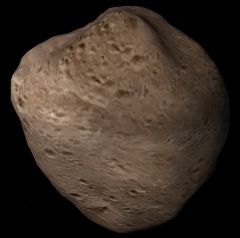Difference between revisions of "Kerberos"
Jump to navigation
Jump to search
(Arvil moved page User:Arvil/Sandbox02 to Cleo: Move to article page.) Tag: New redirect |
(Created page.) Tag: Removed redirect |
||
| Line 1: | Line 1: | ||
| − | + | {| cellpadding="2" cellspacing="0" style="margin:25px 0 0 10px; border:3px solid lightsteelblue;width:250px; font-size:90%; font-family:'Arial','Helvetica'; float: right; clear: right;"Pluto in Orbiter" | |
| + | !bgcolor="lightsteelblue" colspan="2" align="center" |Hydra | ||
| + | |- | ||
| + | |colspan="2" align="center"|[[Image:Kerberos-nhplutoenc150703-Orbiter2016D3D9.jpg|Kerberos|240px]] | ||
| + | |- | ||
| + | |colspan="2" align="center"|'''Kerberos from ''Pluto and Moons.zip'' and ''New Horizons Pluto Encounter.zip'' in Orbiter 2016 with D3D9</center> | ||
| + | |- | ||
| + | !bgcolor="lightsteelblue" colspan="2"|Designation | ||
| + | |- | ||
| + | |Name||align="right"|Kerberos | ||
| + | |- | ||
| + | |width="30%"|Reference body||align="right" width="30%"|134340 Pluto | ||
| + | |- | ||
| + | |width="30%"|Number of satellites||align="right" width="30%"| | ||
| + | |- | ||
| + | !bgcolor="lightsteelblue" colspan="2"|Planetary mean orbits | ||
| + | |- | ||
| + | |width="30%"|Epoch||align="right" width="50%"|2015.52772073922 | ||
| + | |- | ||
| + | |width="30%"|Semimajor axis (a)||align="right" width="50%"|66634358.6122471 m | ||
| + | |- | ||
| + | |width="30%"|Eccentricity (e)||align="right" width="30%"|0.202665594100444 | ||
| + | |- | ||
| + | |width="30%"|Inclination (i)||align="right" width="30%"|113.058239379962° <br> (1.97323852368825 radian) | ||
| + | |- | ||
| + | |width="30%"|Longitude of the ascending node (LAN, ☊)||align="right" width="30%"|227.893342417832° <br> (3.97748916856603 radian) | ||
| + | |- | ||
| + | |width="30%"|Longitude of periapsis (ϖ)||align="right" width="30%"|566.461412931116° <br> (9.88661674114716 radian) | ||
| + | |- | ||
| + | |width="30%"|Mean longitude (L)||align="right" width="30%"|604.850209899799° <br> (10.5566276441303 radian) | ||
| + | |- | ||
| + | !bgcolor="lightsteelblue" colspan="2"|Selected physical parameters | ||
| + | |- | ||
| + | |width="30%"|Mean radius||align="right" width="30%"|31000 m | ||
| + | |- | ||
| + | |width="30%"|Mass||align="right" width="30%"|2×10<sup>16</sup> kg | ||
| + | |- | ||
| + | |width="30%"|Sidereal rotation period||align="right" width="30%"|2286523.94967042336 sec (26.464 days) | ||
| + | |- | ||
| + | |width="30%"|SidRotOffset||align="right" width="30%"|0 | ||
| + | |- | ||
| + | |width="30%"|Obliquity||align="right" width="30%"|96.145° (1.67804680932995 radian) | ||
| + | |- | ||
| + | |width="30%"|LAN||align="right" width="30%"|43.046° (0.7512944298135 radian) | ||
| + | |- | ||
| + | |width="30%"|Note||align="right" width="30%"|*Elements given are from Hyra.cfg (New Horizons Pluto Encounter.zip) | ||
| + | |} | ||
| + | |||
| + | '''Keberos S/2011 P 1''' is a small satellite of Pluto. It was discovered in images by the [[w:Hubble Space Telescope|Hubble Space Telescope]] in June 2011 and was named after [[w:Lernaean Hydra|Hydra]], the nine-headed serpent in [[w:Greek mythology|Greek mythology]]. It was named for [[w:Cerberus|Cerberus]] the Hound of Hades in [[w:Greek mythology|Greek mythology]]. | ||
| + | |||
| + | == Hydra in Orbiter == | ||
| + | Hydra was introduced to Orbiter with the release of ''New Horizons Pluto Encounter.zip'' in July 2015. | ||
| + | |||
| + | {| class="wikitable" style="text-align: center" | ||
| + | |colspan="8"|<center>'''Orbiter versions and add-ons which include Hydra'''</center> | ||
| + | |- | ||
| + | !Add-on!!Source!!Version!!Author!!Type!!Release Date!!Compatibility!!Wiki article | ||
| + | |- | ||
| + | |[https://www.orbiter-forum.com/resources/new-horizons-pluto-encounter.3045/ New Horizons Pluto Encounter]||O-F Resources||2015-07-09||BrianJ||Scenarios||9 July 2015|||| | ||
| + | |} | ||
| + | |||
| + | == Gallery == | ||
| + | <gallery widths="100" heights="100"> | ||
| + | Kerberos-nhplutoenc150703-Orbiter2016D3D9.jpg|<center>Kerberos from ''Pluto and Moons.zip'' and ''New Horizons Pluto Encounter.zip'' in Orbiter 2016 with D3D9</center> | ||
| + | Kerberos (moon).jpg|<center>Kerberos imaged by New Horizons a few hours before close approach to Pluto<br>from Wikimedia Commons</center> | ||
| + | Animation of moons of Pluto - Front view.gif|<center>Animation of the moons of Pluto (Pluto white, Charon blue, Styx green, Nix magenta, Kerberos cyan, Hydra red)<br>from Wikimedia Commons</center> | ||
| + | </gallery> | ||
| + | |||
| + | {{Nsat-Stub}} | ||
| + | {{PlutoMoons}} | ||
| + | {{SolarSystem}} | ||
| + | |||
| + | [[Category:Articles]] | ||
| + | [[Category:Celestial bodies]] | ||
| + | [[Category:Solar System]] | ||
| + | [[Category:Natural satellites]] | ||
Revision as of 04:27, 11 November 2024
Keberos S/2011 P 1 is a small satellite of Pluto. It was discovered in images by the Hubble Space Telescope in June 2011 and was named after Hydra, the nine-headed serpent in Greek mythology. It was named for Cerberus the Hound of Hades in Greek mythology.
Hydra in Orbiter
Hydra was introduced to Orbiter with the release of New Horizons Pluto Encounter.zip in July 2015.
| Add-on | Source | Version | Author | Type | Release Date | Compatibility | Wiki article |
|---|---|---|---|---|---|---|---|
| New Horizons Pluto Encounter | O-F Resources | 2015-07-09 | BrianJ | Scenarios | 9 July 2015 | ||
Gallery
 | This natural satellite related article is a stub. You can help Orbiterwiki by expanding it.
| ||||||||||||



